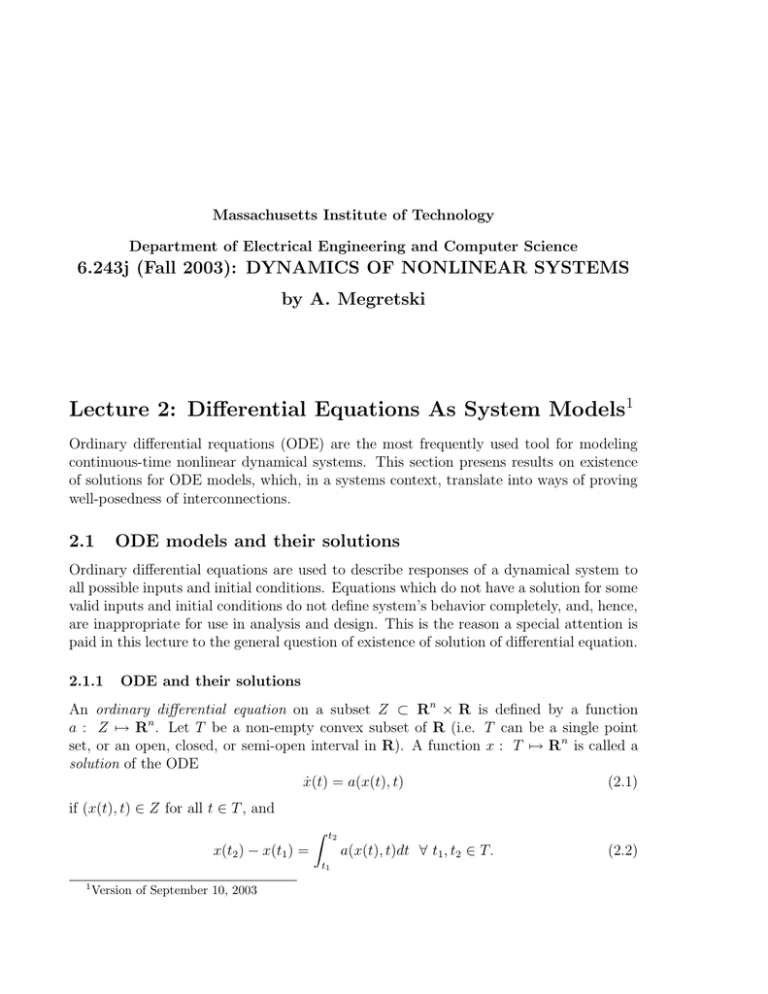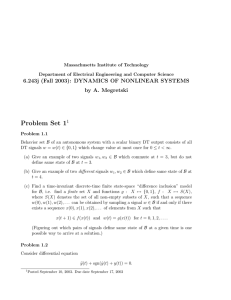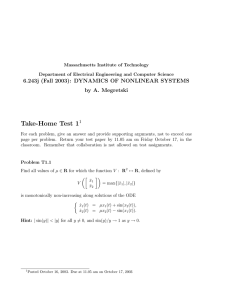Massachusetts Institute of Technology
advertisement

Massachusetts Institute of Technology
Department of Electrical Engineering and Computer Science
6.243j (Fall 2003): DYNAMICS OF NONLINEAR SYSTEMS
by A. Megretski
Lecture 2: Differential Equations As System Models1
Ordinary differential requations (ODE) are the most frequently used tool for modeling
continuous-time nonlinear dynamical systems. This section presens results on existence
of solutions for ODE models, which, in a systems context, translate into ways of proving
well-posedness of interconnections.
2.1
ODE models and their solutions
Ordinary differential equations are used to describe responses of a dynamical system to
all possible inputs and initial conditions. Equations which do not have a solution for some
valid inputs and initial conditions do not define system’s behavior completely, and, hence,
are inappropriate for use in analysis and design. This is the reason a special attention is
paid in this lecture to the general question of existence of solution of differential equation.
2.1.1
ODE and their solutions
An ordinary differential equation on a subset Z � Rn × R is defined by a function
a : Z ∈� Rn . Let T be a non-empty convex subset of R (i.e. T can be a single point
set, or an open, closed, or semi-open interval in R). A function x : T ∈� Rn is called a
solution of the ODE
ẋ(t) = a(x(t), t)
(2.1)
if (x(t), t) ⊂ Z for all t ⊂ T , and
x(t2 ) − x(t1 ) =
�
t2
t1
1
Version of September 10, 2003
a(x(t), t)dt � t1 , t2 ⊂ T.
(2.2)
2
The variable t is usually referred to as the “time”.
Note the use of an integral form in the formal definition (2.2): it assumes that the
function t ∈� a(x(t), t) is integrable on T , but does not require x = x(t) to be differentiable
at any particular point, which turns out to be convenient for working with discontinuous
input signals, such as steps, rectangular impulses, etc.
Example 2.1 Let sgn denote the “sign” function sgn : R � {0, −1, 1} defined by
�
y > 0,
� 1,
0,
y = 0,
sgn(y) =
�
−1, y < 0.
The notation
ẋ = −sgn(x),
(2.3)
which can be thought of as representing the action of an on/off negative feedback (or
describing behavior of velocity subject to dry friction), refers to a differential equation
defined as above with n = 1, Z = R × R (since sgn(x) is defined for all real x, and no
restrictions on x or the time variable are explicitly imposed in (2.3)), and a(x, t) = sgn(x).
It can be verified2 that all solutions of (2.3) have the form
x(t) = max{c − t, 0} or x(t) = min{t − c, 0},
where c is an arbitrary real constant. These solutions are not differentiable at the critical
“stopping moment” t = c.
2.1.2
Standard ODE system models
Ordinary differential equations can be used in many ways for modeling of dynamical
systems. The notion of a standard ODE system model describes the most straightforward
way of doing this.
Definition A standard ODE model B = ODE(f, g) of a system with input v = v(t) ⊂
V � Rm and output w(t) ⊂ W � Rk is defined by a subset X � Rn , two functions
f : X × V × R+ ∈� Rn and g : X × V × R+ ∈� W , and a subset X0 � X, so that the
behavior set B of the system consists of all pairs (v, w) of signals such that v(t) ⊂ V for
all t, and there exist a solution x : R+ ∈� X of the differential equation
ẋ(t) = f (x(t), v(t), t)
(2.4)
w(t) = g(x(t), v(t), t).
(2.5)
such that x(0) ⊂ X0 and
A special case of this definition, when the input v is not present, defines an autonomous
system.
2
Do it as an excercise!
3
2.1.3
Well-posedness of standard ODE system models
As it was mentioned before, not all ODE models are adequate for design and analysis
purposes. The notion of well-posedness introduces some typical constraints aimed at
insuring their applicability.
Definition A standard ODE model ODE(f, g) is called well posed if for every signal
v(t) ⊂ V and for every solution x1 : [0, t1 ] ∈� X of (2.4) with x1 (0) ⊂ X0 there exists a
solution x : R+ ∈� X of (2.4) such that x(t) = x1 (t) for all t ⊂ [0, t1 ].
The ODE from Example 2.1.1 can be used to define a standard autonomous ODE
system model
ẋ(t) = −sgn(x(t)), w(t) = x(t),
where V = X = X0 = R, f (x, v, t) = −sgn(x) and g(x, v, t) = x. It can be verified that
this autonomous system is well-posed. However, introducing an input into the model
destroys well-posedness, as shown in the following example.
Example 2.2 Consider the standard ODE model
ẋ(t) = −sgn(x(t)) + v(t), w(t) = x(t),
(2.6)
where v(t) is an unconstrained scalar input. Here
V = X = X0 = R, f (x, v, t) = −sgn(x) + v, g(x, v, t) = x.
While this model appears to describe a physically plausible situation (velocity dynamics
subject to dry friction and external force input v), the model is not well-posed.
To prove this, consider the input v(t) = 0.5 = const. It is sufficient to show that no
solution of the ODE
ẋ(t) = 0.5 − sgn(x(t))
satisfying x(0) = 0 exists on a time interval [0, tf ] for tf > 0. Indeed, let x = x(t) be such
solution. As an integral of a bounded function, x = x(t) witll be a continuous function
of time. A continuous function over a compact interval always achieves a maximum. Let
tm ⊂ [0, tf ] be an argument of the maximum over t ⊂ [0, tf ].
If x(tm ) > 0 then tm > 0 and, by continuity, x(t) > 0 in a neighborhood of tm , hence
there exists π > 0 such that x(t) > 0 for all t ⊂ [tm − π, tm ]. According to the differential
equation, this means that x(tm −π) = x(tm )+0.5π > x(tm ), which contradicts the selection
of tm as an argument of maximum. Hence max x(t) = 0. Similarly, min x(t) = 0. Hence
x(t) = 0 for all t. But the constant zero function does not satisfy the differentlial equation.
Hence, no solution exists.
It can be shown that the absense of solutions in Example 2.1.3 is caused by lack of
continuity of function f = f (x, v, t) with respect to x (discontinuity with respect to v and
t would not cause as much trouble).
4
2.2
Existence of solutions for continuous ODE
This section contains fundamental results establishing existence of solutions of differential
equations with a continuous right side.
2.2.1
Local existence of solutions for continuous ODE
In this subsection we study solutions x : [t0 , tf ] ∈� Rn of the standard ODE
ẋ(t) = a(x(t), t)
(2.7)
(same as (2.1)), subject to a given initial condition
x(t0 ) = x0 .
(2.8)
Here a : Z ∈� Rn is a given continuous function, defined on Z � Rn × R. It turns out
that a solution x = x(t) of (2.7) with initial condition (2.8) exists, at least on a sufficiently
short time interval, whenever the point z0 = (x0 , t0 ) lies, in a certain sense, in the interior
of Z.
Theorem 2.1 Assume that for some r > 0
Dr (x0 , t0 ) = {(¯
x, t) ⊂ Rn × R : |x¯ − x0 | ∀ r, t ⊂ [t0 , t0 + r]}
is a subset of Z. Let
M = max{|a(¯
x, t)| : (¯
x, t) ⊂ Dr (x0 , t0 )}.
Then, for
tf = min{t0 + r/M, t0 + r},
there exists a solution x : [t0 , tf ] ∈� Rn of (2.7) satisfying (2.8). Moreover, any such
solution also satisfies |x(t) − x0 | ∀ r for all t ⊂ [t0 , tf ].
Example 2.3 The ODE
ẋ(t) = c0 + c1 cos(t) + x(t)2 ,
where c0 , c1 are given constants, belongs to the class of Riccati equations, which play a
prominent role in the linear system theory. According to Theorem 2.1, for any initial
condition x(0) = x0 there exists a solution of the Riccati equation, defined on some time
interval [0, tf ] of positive length. This does not mean, however, that the correspond­
ing autonomous system model (producing output w(t) = x(t)) is well-posed, since such
solutions are not necessarily extendable to the complete time half-line [0, →).
5
2.2.2
Maximal solutions
If x1 : [t0 , t1 ] ∈� Rn and x2 : [t1 , t2 ] ∈� Rn are both solutions of (2.7), and x1 (t1 ) = x2 (t1 ),
then the function x : [t0 , t2 ] ∈� Rn , defined by
⎩
x1 (t), t ⊂ [t0 , t1 ],
x(t) =
x2 (t), t ⊂ [t1 , t2 ],
(i.e. the result of concatenating x1 and x2 ) is also a solution of (2.7). This means that
some solutions of (2.7) can be extended to a larger time interval.
A solution x : T ∈� Rn of (2.7) is called maximal if there exists no other solution
x¯ : T̄ ∈� Rn for which T is a proper subset of T¯, and x(t)
¯
= x(t) for all t ⊂ T . In
particular, well-posedness of standard ODE system models contains the requirement that
all maximal solutions must be defined on the whole time-line t ⊂ [0, →).
The following theorem gives a useful characterization of maximal solutions.
Theorem 2.2 Let X be an open subset of Rn . Let a : X × R ∈� Rn be a continuous
function. Then all maximal solutions of (2.7) are defined on open intervals and, whenever
such solution x : (t0 , t1 ) ∈� X has a finite interval end t¯ = t0 ⊂ R or t̄ = t1 ⊂ R (as
opposed to t0 = −→ or t1 = →), there exists no sequence tk ⊂ (t0 , t1 ) such that tk
converges to t̄ while x(tk ) converges to a limit in X.
In other words, in the absense of a-priori constraints on the time variable, a solution is
not extendable only if x(t) converges to the boundary of the set on which a is defined. In
the most typical situation, the domain Z of f in (2.4) is Rn × R+ , which means no a-priori
constraints on either x or t. In this case, according to Theorem 2.2, a solution x = x(t)
not extendable over a finite time interval [0, tf ), tf < →, must satisfy the condition
lim |x(t)| = →.
t�tf
In Example 2.2.1 with c0 = 1, c1 = 0, one maximal ODE solution is x(t) = tan(t),
defined for t ⊂ (−�/2, �/2). It cannot be extended on either side because |x(t)| � → as
t � �/2 or t � −�/2.
2.2.3
Discontinuous dependence on time
The ODE describing systems dynamics are frequently discontinuous with respect to the
time variable. Indeed, the standard ODE system model includes
ẋ(t) = f (x(t), v(t), t),
where v = v(t) is an input, and the ODE becomes discontinuous with respect to t when­
ever v is a rectangular impulse etc. As long as the time instances at which a(x, t) is
6
discontinuous for a fixed finite set t1 < t2 < · · · < tn , Theorem 2.1 can be applied
separately to the time intervals [tk−1 , tk ]. However, when the location of discontinuities
depends on x, or when they cannot be counted in an increasing order, a stronger result
is needed. It turns out that the dependence on time needs only be integrable, as long as
dependence on x is continuous.
Theorem 2.3 Assume that for some r > 0
(a) the set
Dr (x0 , t0 ) = {(x, t) ⊂ Rn × R : |x − x0 | ∀ r, t ⊂ [t0 , t0 + r]}
is a subset of Z;
(b) the function t ∈� a(x(t), t) is integrable on [t0 , t0 + r] for every continuous function
x : [t0 , t0 + r] ∈� Rn satisfying |x(t) − x0 | ∀ r for all t ⊂ [t0 , t0 + r];
(c) for every π > 0 there exists � > 0 such that
� t0 +r
|a(x1 (t), t) − a(x2 (t), t)|dt < π
t0
whenever x1 , x2 : [t0 , t0 +r] ∈� Rn are continuous functions satisfying |xk (t)−x0 | ∀ r
and |x1 (t) − x2 (t)| < � for all t ⊂ [t0 , t0 + r].
Then, for some tf ⊂ (t0 , t0 + r) there exists a solution x : [t0 , tf ] ∈� Rn of (2.7) satisfying
(2.8).
Example 2.4 Theorem 2.3 can be used to show that the differential equation
⎩ −1/3
t
x(t), t > 0
ẋ(t) =
x(0) = x0
0,
t = 0,
does have a solution on [0, →) for every x0 ⊂ R (in this particular case the solutions can
be found analytically). Indeed, for every continuous function x : [0, →) ∈� R the function
t ∈� t−1/3 x(t) for t > 0 is integrable over every finite interval, and the inequality
� t1
� t1
−1/3
−1/3
|t
x1 (t) − t
x2 (t)|dt ∀
t−1/3 dt max |x1 (t) − x2 (t)|
0
0
holds.
On the contrary, the differential equation
⎩ −1
t x(t), t > 0
ẋ(t) =
0,
t = 0,
t�[0,t1 ]
x(0) = x0
does not have a solution on [0, →) for every x0 ∞= 0. Indeed, if x : [0, t1 ] ∈� R is a solution
for some t1 > 0 then
⎧
⎨
d x(t)
=0
dt
t
for all t ∞= 0. Hence x(t) = ct for some constant c, and x(0) = 0.
7
2.2.4
Differential inclusions
n
Let X be a subset of Rn , and let � : X � 2R be a function which maps every point of
X to a subset of Rn . Such a function defines a differential inclusion
ẋ(t) ⊂ �(x(t)).
(2.9)
By a solution of (2.1) on a convex subset T of R we mean a function x : T ∈� X such
that
� t2
x(t2 ) − x(t1 ) =
u(t)dt � t1 , t2 ⊂ T
t1
for some integrable function u : T ∈� Rn satisfying the inclusion u(t) ⊂ �(x(t)) for
all t ⊂ T . It turns out that differential inclusions are a convenient, though not always
adequate, way of re-defining discontinuous ODE to guarantee existence of solutions.
It turns out that differential inclusion (2.9) subject to fixed initial condition x(t 0 ) = x0
has a solution on a sufficiently small interval T = [t0 , t1 ] whenever the set-valued function
� is compact convex set-valued and semicontinuous with respect to its argument (plus, as
usually, x0 must be an interior point of X).
Theorem 2.4 Assume that for some r > 0
(a) the set
Br (x0 ) = {x ⊂ Rn : |x − x0 | ∀ r}
is a subset of X;
(b) for every x¯ ⊂ Br (x0 ) the set �(¯
x) is convex;
(c) for every sequence of x¯k ⊂ Br (x0 ) converging to a limit x¯ ⊂ Br (x0 ) and for every
sequence u¯k ⊂ �(¯
xk ) there exists a subsequence k = k(q) � → as q � → such that
the subsequence u¯k(q) has a limit in �(¯
x).
Then the supremum
M = sup{|¯
u| : u¯ ⊂ �(¯
x), x¯ ⊂ Dr (x0 , t0 )}
is finite, and, for
tf = min{t0 + r/M, t0 + r},
there exists a solution x : [t0 , tf ] ∈� Rn of (2.9) satisfying x(t0 ) = x0 . Moreover, any
such solution also satisfies |x(t) − x0 | ∀ r for all t ⊂ [t0 , tf ].
The discontinuous differential equation
ẋ(t) = −sgn(x(t)) + c,
8
where c is a fixed constant, can be re-defined as a continuous differential inclusion (2.9)
by introducing
�
y > 0,
� {c − 1},
[c − 1, c + 1], y = 0,
�(y) =
�
{c + 1},
y < 0.
The newly obtained differential inclusion has the “existence of solutions” property, and
appears to be compatible with the “dry friction” interpretation of the sign nonlinearity.
In particular, with the initial condition x(0) = 0, the equation has solutions for every
value of c ⊂ R. If c ⊂ [−1, 1], the unique maximal solution is x(t) ≤ 0, which corresponds
to the friction force “adapting” itself to equalize the external force, as long as it is not
too large.
The differential inclusion model is not as compatible with the “on/off controller”
interpretation of the sign nonlinearity. In this case, due to the unmodeled feedback
loop delays, one expects some “chattering” solutions oscillating rapidly around the point
x0 = 0. It is possible to say that, in this particular case, the solutions of (2.9) describe
the limit behavior of the closed loop solutions as the loop delay approaches zero.




